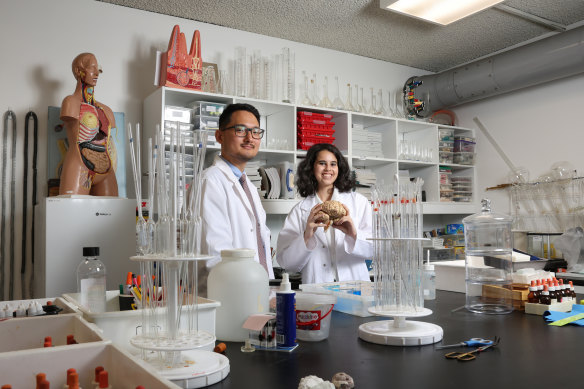By Christopher Harris and Lucy Carroll
Before a typical science lesson at Ryde Secondary College, students line up outside the classroom, and, once at their desks, start the period with a fast-paced set task and take notes by hand.
The head of the school’s science faculty, George An, says he follows a “chalk and talk” approach, where he explains a concept to the class, writing key points on the board that students copy down.

Ryde Secondary College student Jasmine Virk and head of science George An.Credit: Dylan Coker
“For students to process new information, they have to link it to prior information to draw meaning from it … learning something new is difficult,” he said. “If you blast them with PowerPoints, you’re relying on them to summarise it themselves, and the vast majority would not.”
The lessons must be engaging, he says, and he’s not averse to the odd YouTube video to spark student interest. “I’m a big fan of technology, when it can be used to enhance learning and add something that couldn’t be achieved via textbook or workbook.”
The latest Programme for International Student Assessment (PISA) results, released globally on Tuesday night, showed Australian students achieved an average of 507 points in scientific literacy, above the OECD average of 485.
NSW recorded its biggest gains in science: both girls and boys are now six months ahead in their learning compared with 2018 results, with the state reporting an overall increase of 12 points.
While NSW results show students’ average science score has declined by 27 points since the domain was first assessed in 2006, results across Australia have flatlined since the last testing period and the proportion of low performers has increased.
The latest global tests assessed the scientific, reading and mathematical literacy of 15-year-olds in 81 countries, including 3200 NSW students from 174 public and non-government schools.
A spokesperson for the NSW Education Department said the state’s science results bucked the global trend, while also noting the report “vindicates the state government’s mobile phone ban in schools”, after the OECD findings showed 40 per cent of Australian students were distracted by digital devices.
On Thursday, the NSW Education Standards Authority will release a revamped year 7 to 10 syllabus, the first major update in more than a decade. The overhaul will embed more explicit maths instruction in high school science, introduce a new data science topic, and deepen the study of climate science.
The changes are part of NSW’s once-in-a-generation curriculum reform, with NESA also redesigning the state’s maths curriculum, which will abolish a three-tiered course structure in favour of a single “core” unit of work which teachers will top up with extra content.
The new science syllabus, to be taught from 2026, will also include compulsory content on using and solving chemical equations, and more maths content in electricity and physics topics.
President of the NSW Science Teachers’ Association Margaret Shepherd said NSW had improved results due to effective teaching in high school science of higher-order thinking skills, critical thinking and scientific inquiry.
At Ryde Secondary College, An said across year 7 to 10 science classes he has engineered the timetable so one teacher will deliver the same lesson three times in the same day.
It frees up teacher time while they become increasingly adept at teaching a concept, he explains. Faculty staff use the same resources and scope and sequence, a practice mirrored in high-performing countries like Singapore.
“It is madness to think every school has to make their own teaching program, sequence it in a way they think is good. We’re saturated with resources, so you need to curate that,” An said.
He said one focus areas is helping younger teachers manage a classroom. “One thing we’ve introduced is a ‘do now’ activity – or a quick set task – at the start of each lesson to help students engage with learning straight away,” he says.
“If the lesson is that not engaging, it is natural for a kid to go off task. But we also have to impart self-regulation and the ability to power through that boredom.”
A Department spokesperson said NSW teachers deserves high praise for helping students achieve improved PISA results in science, despite the enormous challenges and disrupted schooling during the pandemic.
“Our teachers focus on developing critical thinking, applying scientific knowledge and skills and reaching evidence-based conclusions. At the same time our teachers, despite staffing challenges across the system, ensure that our students are known, valued and cared for – we could not ask for anything more from a deeply committed profession,” they said.
Start the day with a summary of the day’s most important and interesting stories, analysis and insights. Sign up for our Morning Edition newsletter.